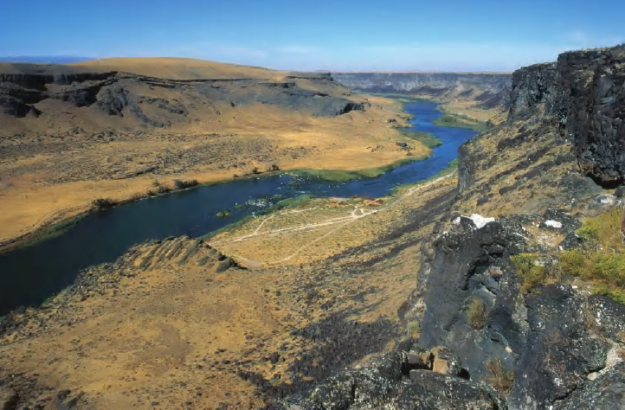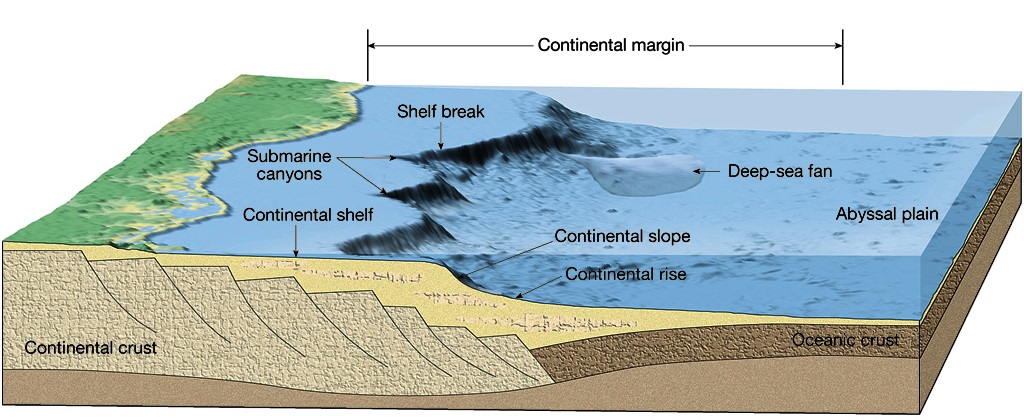A large igneous province, also known as a continental flood basalt, plateau basalt, and trap, is deposits that include vast plateaus of basalts, covering large areas of some continents. They have a tholeiitic basalt composition, but some show chemical evidence of minor contamination by continental crust. They are similar to anomalously thick and topographically high seafloor known as oceanic plateaus and to some volcanic rifted passive margins. in numerous instances over the past several hundred million years these vast outpourings of lava have accumulated, forming thick piles of basalt, representing the largest-known volcanic episodes on the planet. These piles of volcanic rock represent times when the Earth moved more material and energy from its interior than during intervals between the massive volcanic events. such large amounts of volcanism also released large amounts of volcanic gases into the atmosphere, with serious implications for global temperatures and climate and may have contributed to some global mass extinctions.

Figure 1: Map of the world showing distribution of flood basalts.
The largest continental flood basalt province in the united states is the Columbia River flood basalt in Washington, oregon, and Idaho. The Columbia River flood basalt province is 6–17 million years old and contains an estimated 4,900 km³ of basalt. individual lava flows erupted through fissures or cracks in the crust, then flowed laterally across the plain for up to 645 km.
The 66-million-year-old Deccan flood basalts, also known as traps, cover a large part of western India and the seychelles. They are associated with the breakup of India from the seychelles during the opening of the indian ocean. slightly older flood basalts (90–83 million years old) are associated with the breakaway of madagascar from India. The volume of the Deccan traps is estimated to be 20,840,000 km³. This huge volume of volcanic rocks erupted over a period of about 1 million years, starting slightly before the great Cretaceous-Tertiary extinction. most workers now agree that the gases released during the flood basalt volcanism stressed the global biosphere to such an extent that many marine organisms had gone extinct, and many others were stressed. Then the planet was hit by the massive Chicxulub impact, causing the massive extinction that included the end of the dinosaurs.

Figure 2: Columbia River flood basalts along Snake River Birds of Prey National Conservation Area near Boise, Idaho (David R. Frazier/Photo Researchers, Inc.)
The breakup of east Africa along the East African rift system and the Red Sea is associated with large amounts of Cenozoic (fewer than 30 million years old) continental flood basalts. Some of the older volcanic fields are located in east Africa in the Afar region of Ethiopia, south into Kenya and Uganda, and north across the Red Sea and Gulf of Aden into Yemen and Saudi Arabia. These volcanic piles underlie younger (fewer than 15-million-year old) flood basalts that extend both farther south into Tanzania and farther north through central Arabia, where they are known as Harrats, and into Syria, Israel, Lebanon, and Jordan.
An older volcanic province, the North Atlantic Igneous Province, also associated with the breakup of a continent, formed along with the breakup of the North Atlantic Ocean at 62–55 million years ago. The North Atlantic Igneous Province includes both onshore and offshore volcanic flows and intrusions in Greenland, Iceland, and the northern British Isles, including most of the Rockall Plateau and Faeroe Islands. The opening of the ocean in the south Atlantic is similar to 129–134-million-year-old flood basalts, which, now split in half, comprise two parts. In Brazil the flood lavas are known as the Paraná basalts, and in Namibia and Angola of west Africa, as the Etendeka basalts.
These breakup basalts are transitional to submarine flood basalts that form oceanic plateaus. The Caribbean Ocean floor is one of the best examples of an oceanic plateau, with other major examples including the Ontong-Java Plateau, Manihiki Plateau, Hess Rise, Shatsky Rise, and Mid-Pacific Mountains. All of these oceanic plateaus contain between 10–40-km thick piles of volcanic and subvolcanic rocks, representing huge outpourings of lava. The Caribbean seafloor preserves 8–21-km thick oceanic crust formed before about 85 million years ago in the eastern Pacific Ocean. This unusually thick ocean floor was transported eastward by plate tectonics, where pieces of the seafloor collided with South America as it passed into the Atlantic Ocean. Pieces of the Caribbean oceanic crust are now preserved in Colombia, Ecuador, Panama, Hispaniola, and Cuba, and some scientists estimate that the Caribbean oceanic plateau was once twice its present size. In either case it represents a vast outpouring of lava that would have been associated with significant outgassing, with possible consequences for global climate and evolution.
The western Pacific Ocean basin contains several large oceanic plateaus, including the 32-km thick crust of the Alaskan-sized Ontong-Java Plateau, the largest outpouring of volcanic rocks on the planet. Having formed in two intervals, at 122 and 90 million years ago, respectively, entirely within the ocean, the Ontong-Java Plateau represents magma that rose in a plume from deep within the mantle and erupted on the seafloor. Estimates suggest that the volume of magma erupted in the first event was equivalent to that of all the magma being erupted at midocean ridges at the present time. Sea levels rose by more than 9 m in response to this volcanic outpouring. The gases released during these eruptions are estimated to have raised average global temperatures by 13°C.
ENVIRONMENTAL HAZARDS OF FLOOD BASALT VOLCANISM
The environmental impact of the eruption of large volumes of basalt in provinces including those described above can be severe. Huge volumes of sulfur dioxide, carbon dioxide, chlorine, and fluorine are released during large basaltic eruptions. Much of this gas may get injected into the upper troposphere and lower stratosphere during the eruption process, being released from eruption columns that reach two to 3–13 km in height. Carbon dioxide is a greenhouse gas and can cause global warming, whereas sulfur dioxide and hydrogen sulfate have the opposite effect: they can cause short-term cooling. Many of the episodes of volcanism preserved in these large igneous provinces were rapid, repeatedly releasing enormous quantities of gases over periods of fewer than 1 million years, and releasing enough gas to change the climate significantly and more rapidly than organisms could adapt. For instance, one eruption of the Columbia River basalts is estimated to have released 9 billion tons of sulfur dioxide and thousands of millions of tons of other gases, whereas the eruption of Mount Pinatubo in 1991 released about 20 million tons of sulfur dioxide.
The Columbia River basalts of the Pacific Northwest continued erupting for years at a time, for approximately 1 million years. During this time the gases released would be equivalent to that of Mount Pinatubo every week, maintained for decades to thousands of years at a time. The atmospheric consequences are sobering. Sulfuric acid aerosols and acid from the fluorine and chlorine would form extensive poisonous acid rain, destroying habitats and making waters uninhabitable for some organisms. At the very least the environmental consequences would be such that organisms were stressed to the point that they would be unable to handle an additional environmental stress, such as a global volcanic winter and subsequent warming caused by a giant impact.
Faunal extinctions have been correlated with the eruption of the Deccan flood basalts at the Cretaceous- Tertiary (K/T) boundary, and with the Siberian flood basalts at the Permian-Triassic boundary. There is still considerable debate about the relative significance of flood basalt volcanism and impacts of meteorites for extinction events, particularly at the Cretaceous-Tertiary boundary. Most scientists would now agree, however, that global environment was stressed shortly before the K/T boundary by volcanic-induced climate change, and then a huge meteorite hit the Yucatán Peninsula, forming the Chicxulub impact crater and causing the massive K/T boundary extinction and the death of the dinosaurs.
The Siberian flood basalts cover a large area of the Central Siberian Plateau northwest of Lake Baikal. They are more than half a mile thick over an area of 543,900 km² but have been significantly eroded from an estimated volume of 3,211,600 km³. They were erupted over an extraordinarily short period of fewer than 1 million years, 250 million years ago, at the Permian-Triassic boundary. They are remarkably coincident in time with the major Permian-Triassic extinction, implying a causal link. The Permian-Triassic boundary at 250 million years ago marks the greatest extinction in Earth history, when 90 percent of marine species and 70 percent of terrestrial vertebrates became extinct. It has been postulated that the rapid volcanism and degassing released enough sulfur dioxide to cause a rapid global cooling, inducing a short ice age with associated rapid fall of sea level. Soon after the ice age took hold, the effects of the carbon dioxide took over and the atmosphere heated to cause global warming. The rapidly fluctuating climate postulated to have been caused by the volcanic gases is thought to have killed off many organisms, which were simply unable to cope with the wildly fluctuating climate extremes.









